Know-how
Thanks to many years of experience, we can offer our customers a solution for every requirement.
Know-how
Thanks to our many years of experience, we can find a suitable solution for every requirement. Only with the right process, high-quality products and precisely fitting individual parts, the best feeding and extrusion results can be achieved.
With the right feeding tool, you adapt your feeding device exactly to the product and thus achieve the best results. In addition to standard feeding tools, we also manufacture special screws from 5 mm to 130 mm screw diameter, single-, double- or multi-flight, linear, conical progressive or relief ground.
Single screw feeders
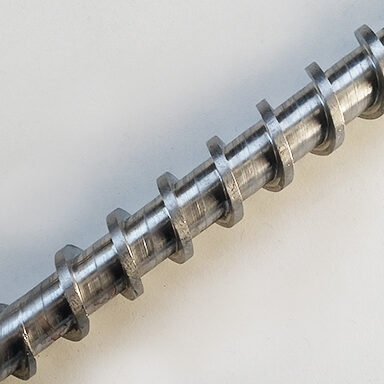
Auger feeding tool with core
For shooting products and small feeding rates
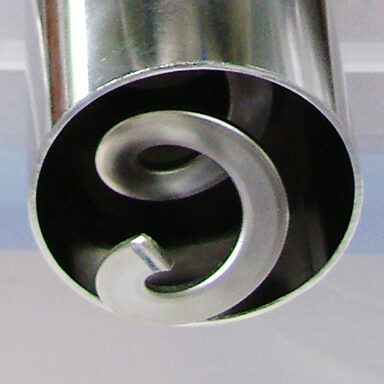
Auger feeding tool without core
For non-shooting products and large feeding rates
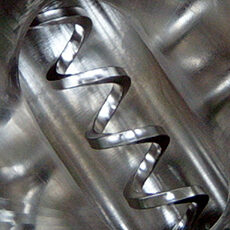
Spiral screw
For applications that are gentle on the product and medium feeding rates
Flat-bottom and twin-screw feeders
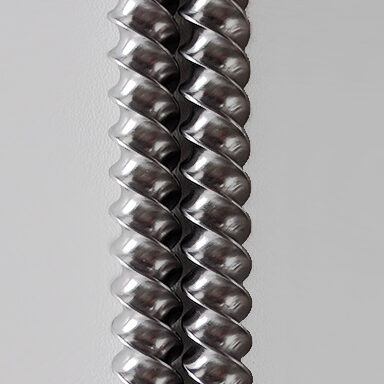
Double concave screw
For applications that are gentle on the product and medium feeding rates
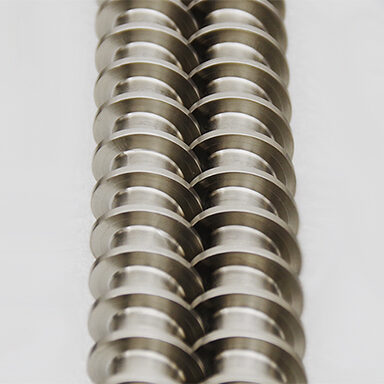
Auger feeding tool with core
For shooting products and small feeding rates
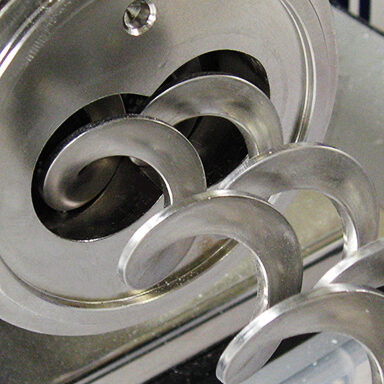
Auger feeding tool without core
For non-shooting products and large feeding rates
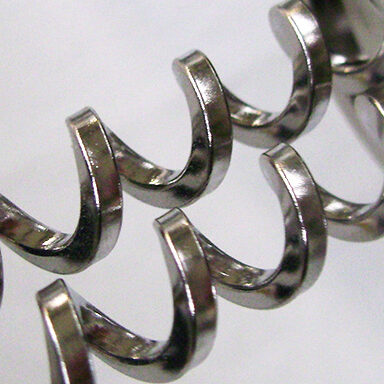
Spiral screw
For applications that are gentle on the product or products of different shapes and medium feeding capacities
Choosing the right hopper, suitable for the properties of the product to be fed, guarantees optimal feeding.
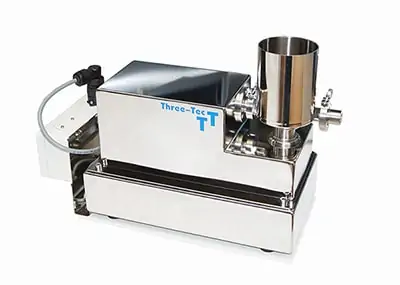
ZD 9 FB feeding system with scale
Often powders for the pharmaceutical industry tend to flow poorly or clump together, which affects the dosing and particle distribution in a vibratory feeder. Therefore, twin screw feeders, as developed by Three-Tec in all variants, advantageously with double concave screws, are the best choice. The intermeshing of the screw flights promotes forced feeding of the powder. The dosing accuracy depends on various conditions. Therefore, screw feeders can be used as volumetric or gravimetric versions. A volumetric feeder can be used if acceptable empirical values prevail due to free-flowing powder with constant bulk density. Volumetric dosing is a function of the screw speed, which means that dosing errors remain unnoticed. Dosing errors occur with volumetric dosing systems at:
- changes in bulk density
- uneven filling of the screw
- sticking or caking powders
- bridging in the feeding hopper
- feeding systems with very short throughput times
- empty hoppers
Gravimetric feeding systems with loss-in-weight scales ensure continuous weighing of the powder. The continuous weighing of the complete feeding system (negative weighing) allows precise control of the feeding. This feature makes it possible to accurately feed even difficult products, which makes gravimetric feeding systems very popular in the pharmaceutical industry.
Gravimetric feeding systems from Three-Tec offer the following advantages:
- constant feeding rates, high accuracy, minimum setpoint deviation
- monitoring of the feeding task and alarm triggering when limit values are exceeded
- digital load cells for high accuracies
- level control
- recording of actual values, average values, etc.
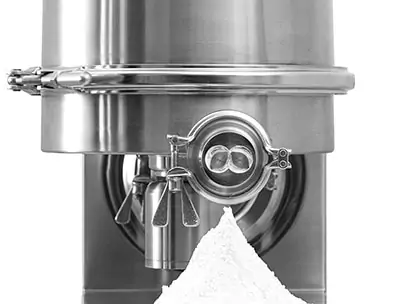
Three-Tec instruments are designed and manufactured in compliance with GMP and can be optionally supplemented with the following options:
- Factory Acceptance Test (FAT) at Three-Tec
- Acceptance (SAT) at the customer
- Installation Qualification (IQ) and Operation Qualification (OQ)
To avoid cross-contamination with chemical, physiological or microbiological substances, Three-Tec has developed the device types ZD xx Pharma with the corresponding design features, such as bswp. clamp fittings, were developed for the food and pharmaceutical industries. For an uncomplicated assembly and disassembly as well as a quick and easy cleaning, corresponding solution principles were realized.
A variety of optional features allow the dosing devices to be optimally adapted to the respective and specific dosing tasks. To ensure a smooth flow of the product to be dosed into the conveying channel, the dosing devices work with specially developed and product-friendly bridge breakers or, for more sensitive products, with bottom scrapers. Parts in contact with the product and all seals are free of PAHs and phthalates. Thanks to additional design measures such as low Ra roughness values, non-porous welded seams and the avoidance of cavities and radial corners and edges, these dispensers comply with GMP and FDA guidelines.
All feeding systems can be realized in volumetric or gravimetric design. The Loss-in-weight scales or platform scales developed by Three-Tec can be easily dismantled and cleaned, making them ideal for pollution-intensive environments.
In order to prevent the product from escaping from the system due to exhaust air flows, suction or pressure equalization devices tailored to the feeding systems have been developed, which can be easily mounted on the discharge pipe and hopper lid using quick-release rings.
Bioavailability is a measure of the proportion of an active ingredient that is available in the circulation (mostly in the blood) and indicates how quickly and to what extent the active ingredient is absorbed and is available at the site of action. Melt extrusion increases the bioavailability of active ingredients. In the polymer and food industries, melt extrusion is a widely used process for the production of molding compounds and is increasingly used in the pharmaceutical industry for the production of new drug formulations.
The proportion of poorly soluble active ingredients in the pharmaceutical industry is clearly predominant and continues to rise. These often enter the bloodstream only with difficulty and their effect is inhibited. Melt/wet extrusion can be used to combine poorly soluble active ingredients with pharmaceutical polymers, thereby increasing their solubility and thus also their bioavailability. Melt extrusion creates a solid dispersion in which the polymer stabilizes the active ingredient and bioavailability accordingly. The active ingredient particles can be reduced down to the molecular level and their solubility enormously increased without the addition of solvent. The following possibilities are realized individually or in combination: Particle reduction, amorphization, salt formation, solubility enhancing excipients, supersaturation stabilizing excipients.
In melt extrusion, active pharmaceutical ingredients (phases to be dispersed) are plasticized/melted together with a polymer (dispersing agent) and any excipients using Three-Tec's laboratory extruders, mixed homogeneously and brought into a stable form (stable dispersion). In wet extrusion, plasticization is carried out using solvents, usually water. Extrusion takes place at room temperature.
Advantages of melt extrusion of active ingredients:
- solvent-free process (melt extrusion)
- no temperature load (moisture extrusion)
- environmentally friendly and economical process
- Dry processing of moisture-sensitive substances (melt extrusion)
- fast, cost-effective method for improving the solubility of poorly soluble active ingredients
- ideal process for masking bad-tasting active ingredients
- simple and reliable method to realize time-delayed drug release, lower risk of drop discharge
- fast and reliable method for producing coating or patches containing active ingredients
- continuous process with fewer individual steps, efficient upscaling from laboratory to production scale
- With downstream calendering, the finished dosage form tablet can be produced in a single manufacturing step, while conventional granulation requires 5-7 manufacturing steps.
- Since no tableting excipients are necessary, the amount of active ingredient and functional excipients can be 100 %
- intensive mixing process ensures an even distribution of active ingredients
- no compression required, therefore suitable for low compressible powders
- fewer auxiliaries needed because polymers can be designed to perform multiple tasks
- higher thermodynamic stability than other melting processes, thus lower tendency to recrystallization
The hot melt extrusion process is suitable for the continuous production of dispersions with polymers as dispersants (carrier substances) and active ingredients. Three-Tec extruders are designed for precisely this area and particularly increase the bioavailability of poorly soluble active ingredients through a sophisticated extrusion process.
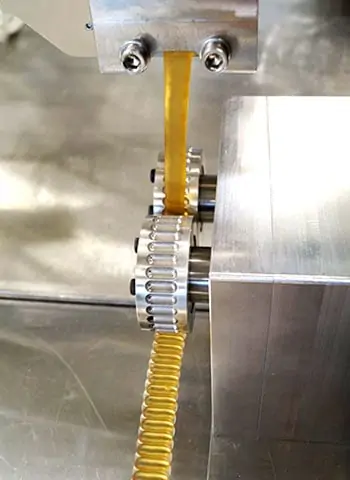
Advantages of the hot melt or wet extrusion process over other processing methods such as the fluidised bed process:
- improved bioavailability of the active ingredients
- hardly soluble substances possible as tablets
- The solubility of the active ingredients is increased
- Individual release profiles can be realized
- Well adjustable retarding effect due to retarding excipients that can simultaneously serve for plasticization
- thermal stress on the active ingredients, carriers and auxiliaries is very low due to the short residence times in the extruder
- homogeneous mixing effect of all substances in the process chamber (feed, barrel, die)
- recipes and quality reproducible
Extruders have been used for mixing, homogenizing and outgassing substances in the chemical and plastics industries for over 50 years. In the pharmaceutical industry, twin screw extruders have been used for the production of pharmaceutical compounds since the 1980s. Three-Tec develops extrusion lines suitable for pharmaceuticals for these purposes. In addition to proven extrusion technology, Three-Tec develops machines that meet the requirements for materials and surfaces.
Three-Tec extruders are modular in design and allow optimum adaptation to the respective process task. Carrier materials, active ingredients and auxiliary materials are quickly homogenized, shaped and further processed directly at the die plate or via peripheral equipment.
The raw materials are added to the process section continuously, in precisely fed quantities. Solid or liquid substances can be fed into the mixing chamber by means of additional feeding devices. The co-rotating screws with conveying, mixing and kneading zones homogenize the dispersion.
For melt extrusion, the formulation must contain at least 7 to 15 % of material plasticizable at higher temperature. The necessary extrusion temperatures are usually 5 to 15 °C below the melting temperatures of the plasticizing auxiliaries/active ingredients. To improve solubility, true melting of the formulation in the medium barrel range can be advantageous; for shaping, it must then be cooled again before the die plate to the temperature that enables dimensionally stable extrudates.
In wet extrusion, the plasticizing solvent, usually water, is added a few centimetres after the powder is applied (organic solvents are also added for moisture-sensitive formulations). This eliminates the need for plasticizing/melting and cooling the product. Instead, the product must be moistened and dried again after the extrusion process. For small batches, it can be advantageous to moisten the powder before extrusion and dose it manually. This saves the running-in phase and reduces the loss of active ingredients.
Contact
Do you have questions about the feeding or extrusion process? We will be happy to advise you.







